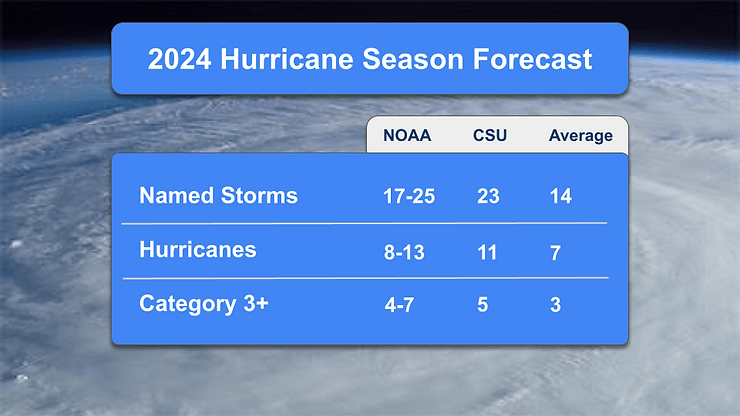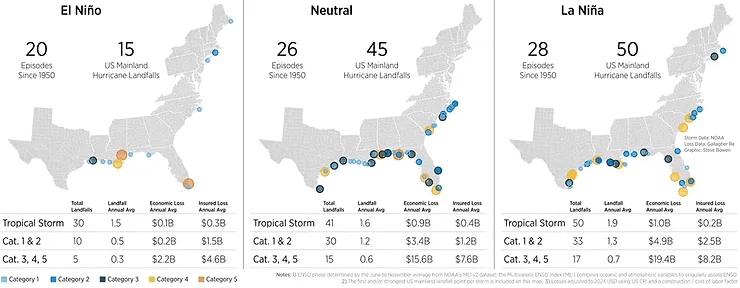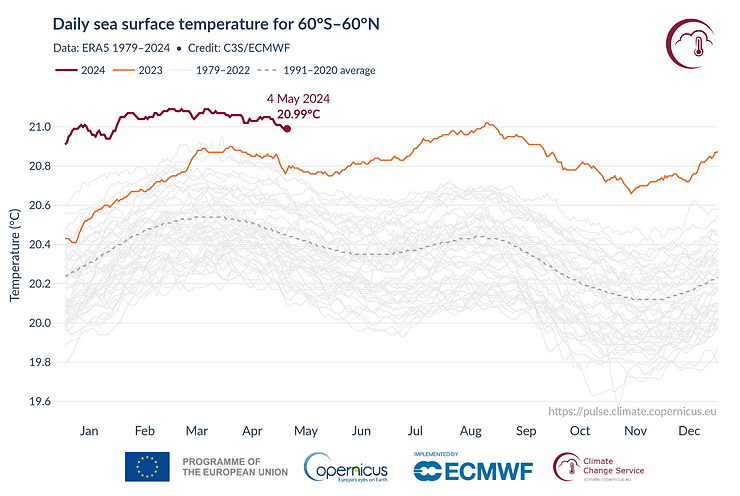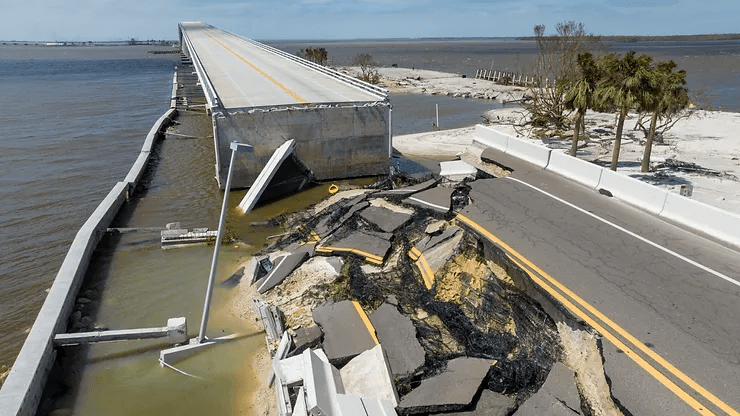Preparing the Transportation Industry for a Potential Record-Breaking Hurricane Season
This hurricane season is shaping up to be exceptionally intense, with storms like Hurricane Beryl and Debby already wreaking havoc on communities and roadways throughout North America. As we approach the peak of hurricane season in August and September, the likelihood of powerful storms will increase. In this article, we'll look at how the season is developing, what transportation companies need to look out for, and how Trimble and weather intelligence firm WeatherOptics are working together to keep drivers and fleets safe with real-time weather updates provided in Trimble’s CoPilot navigation app.
A combination of record-breaking oceanic warmth and a swift transition from a strong El Niño to a La Niña is setting the stage for what could be a record-breaking hurricane season, and the meteorological community is becoming increasingly concerned. The 2024 hurricane season forecast is the most aggressive ever, with the possibility of up to 25 named storms and 13 hurricanes.
“The tropical Atlantic is like a powder keg this year, storing an immense quantity of fuel for hurricanes as it experiences record warm sea surface temperatures,” said Joshua Feldman, Head of Meteorology at WeatherOptics. “Without wind shear to disrupt hurricane circulations due to a La Niña summer, tropical cyclones will be frequent and have a propensity for both longevity and rapid intensification.”
Hurricane-prone communities need to pay close attention, and businesses must ensure they have an action plan with the proper weather risk and impact tools.
Understanding the 2024 Hurricane Season Predictions
The annual hurricane season forecast dates back to 1998 and 1984, when the National Oceanic and Atmospheric Administration (NOAA) and Colorado State University (CSU) first began issuing outlooks, respectively. For decades, it has been a pillar of weather prediction.
NOAA’s 2024 Outlook: The agency predicts an 85% chance of an above-average season, the 8th above-average season in the last ten years. Here’s a breakdown:
-
- Named Storms: 17-25
- Hurricanes: 8-13
- Major Hurricanes (Cat 3+): 4-7
CSU’s 2024 Outlook: The university is predicting a similar highly active season, along with much higher odds of a major hurricane hitting the US, which includes a 42% chance for the Gulf Coast.
-
- Named Storms: 23
- Hurricanes: 11
- Major Hurricanes (Cat 3+): 5
Compared to an average hurricane season (1991-2020), which typically features 14 named storms, seven hurricanes, and three major hurricanes, NOAA and CSU are predicting an 85% and 57% increase in hurricanes for 2024.

The Chance of a Major Hurricane Hitting the US
The CSU hurricane forecasting team, led by Dr. Phil Klotzbach, is considered one of the best for long-range hurricane predictions. They forecast using a statistical model that leverages 40+ years of past Atlantic hurricane statistics, along with dynamical model output from four major NWP agencies: ECMWF, UKMET, JMA, and CMCC.
2024 is the most aggressive forecast they have ever issued in the 30 years the team has produced pre-season outlooks. Forecast confidence is also unusually high.
Based on their modeling, CSU predicts a higher than normal chance of a major hurricane hitting the US coastline compared to average. Here’s the breakdown:
-
- Overall Chances of landfall: 62% (average 43%)
- East Coast or Florida Peninsula Chances: 34% (average 21%)
- Gulf Coast: 42% chance (average 27%)
- Caribbean: 66% chance (average 47%)
Several key factors have meteorologists concerned about the upcoming hurricane season:
1. A Quick Transition from El Nino to La Nina
According to NOAA’s Climate Prediction Center, there is a 62% chance that La Nina conditions develop between June and August. El Niño and La Niña are the warm and cool phases of the recurring ocean-atmospheric pattern in the equatorial Pacific known as "El Niño Southern Oscillation" (ENSO).
La Niña typically leads to a more active hurricane season by relaxing vertical wind shear, which can tear hurricanes apart and inhibit development throughout the Atlantic Basin. US landfalls by major hurricanes are twice as likely in La Niña years versus El Niño years.

Source: Steve Bowen, Gallagher Re Limited
2. Record-Warm Ocean Temperatures
We are in new territory heading into the 2024 hurricane season. The Atlantic Basin has never experienced the level and coverage of record-breaking sea surface temperatures that we’re currently witnessing. Nearly 90% of the Atlantic Basin is at or above record-breaking temperatures.
The current ocean temperatures are far ahead of the previous record holder set in 2005, a year known as one of the most active and destructive hurricane seasons on record. The most concentrated area of abnormal heat is across the Caribbean, where water temperatures are already warmer than the normal seasonal peak – a temperature that isn’t typically hit until September.

significantly higher compared to temperatures from 1979 to 2022 (gray).
Source: Copernicus Climate Change Service/ECMWF
3. Hurricanes Are Becoming More Frequent and Stronger
Overall, we’ve seen a trend of more named storms and an increased number of major hurricanes since the 1970s and 1980s. The average number of major hurricanes (category 3+) in the 2000s and 2010s was 3.1-3.8 per year, compared to the 1970s and 1980s, when the average was only 1.6 per year.
What an Active Season Means for Businesses
The hyperactive hurricane season poses multiple risks for many business verticals, especially emergency management, supply chain, logistics and trucking. Towns and cities in hurricane-prone areas should prepare ahead of time for the season. Here are some of the most common impacts we see from landfalling hurricanes:
Disrupted Supply Chain and Logistics Operations
-
- Transportation Delays – Hurricanes can lead to significant delays in transportation due to road closures, port shutdowns, and disruptions to air and rail services. This can delay the delivery of goods, affect inventory, and lead to stockouts or overstock situations.
- Route Changes & Increased Operation Costs – Businesses may need to reroute shipments to avoid affected areas, which often leads to increased fuel costs and longer delivery times. This can result in higher operational costs and impact the efficiency of logistics operations.
- Labor & Workforce Challenges – Severe weather can prevent employees from reaching work, especially in transportation and warehousing. This can slow down operations and significantly reduce productivity.
Damage to Critical Infrastructure
-
- Facility Damage – Hurricanes can cause extensive damage to warehouses, distribution centers, manufacturing plants, and even office buildings. Businesses may face costly repairs and operational interruptions while they rebuild or relocate.
- Power Outages – Hurricanes can wreak havoc on power lines and cause widespread outages that last for days or weeks. This can halt production, spoil perishable goods, and disrupt communications. Backup power solutions may help but can be costly to implement and maintain, and they may not last for the necessary time.
- Communication Disruptions – Damage to communication infrastructure can make coordination and information flow difficult for emergency managers. It can also further interrupt the supply chain, exacerbating delays and inefficiencies.
Drastic Swings in Supply and Demand
-
- Pre-Hurricane Surge in Demand – We often see a rise in demand for essential goods such as food, water, fuel, and building materials before a hurricane strikes. Businesses must be prepared to meet this spike in demand to maintain customer satisfaction and capitalize on sales.
- Post-Hurricane Supply Shortages – Hurricanes have the potential to severely disrupt supply chains, leading to shortages of goods and materials. Businesses may struggle to restock inventory to meet the sudden surge in demand, particularly for building supplies and materials.
- Fluctuations in Consumer Behavior – Consumer behavior tends to shift before, after, and during hurricanes. We often see an increase in demand for critical goods and supplies and a significant decrease in demand for non-essential items. It can be difficult for businesses to navigate and adapt their inventory and sales strategies to remain competitive.

Source: Steve Helber
How Trimble and WeatherOptics Help Businesses Navigate Hurricane Season
WeatherOptics is designed for businesses to make smarter decisions before, during and after high-impact weather events like hurricanes. Their proprietary, AI-powered weather modeling improves forecast accuracy by up to 50% during severe weather events, and provides actionable intelligence, impact scores, and more through their Insight Portal and APIs.
But through the WeatherOptics partnership with Trimble, we are able to incorporate their insights and data directly into our route optimization and navigation solutions.
As severe weather events occur, WeatherOptics helps us provide transportation and logistics professionals critical predictive information about when and where a driver’s route is expected to be impacted. This information ensures that operations keep moving amid challenges and everyone stays safe on the road. The CoPilot commercial navigation application, for instance, incorporates WeatherOptics insights and data by providing:
-
- In-Cab Alerts – CoPilot provides real-time and predictive updates displayed along a weather overlay on their navigation map, so that drivers have full visibility of weather conditions along their routes and can plan accordingly, minimizing risk. Alerts are route-based instead of strictly location-based, which means they are more precise than what you might get from geofenced NOAA alert services.
- Back-Office Alerts – Fleets gain real-time insights into weather impacts so they can modify trip plans, communicate clear directions to drivers, and rethink strategies as severe weather approaches.
- In-Cab Alerts – CoPilot provides real-time and predictive updates displayed along a weather overlay on their navigation map, so that drivers have full visibility of weather conditions along their routes and can plan accordingly, minimizing risk. Alerts are route-based instead of strictly location-based, which means they are more precise than what you might get from geofenced NOAA alert services.
In both cases, users can receive live email updates about the impact of severe weather events in specified areas, get weather risk warning icons along routes and access detailed geographic data about weather events. Check out our guide to CoPilot’s safety features for more information.
Looking to the Future
Although severe weather like hurricanes can have devastating impacts on local communities and disrupt supply chains and transportation industry operations, there is light on the horizon.
Chances are high that the 2024 hurricane season will be among the most active on record, but through our partnership with WeatherOptics, we can work together to reduce risks of accidents, insurance liabilities and operational costs, all while improving visibility and the driver experience.
Contact our team to learn more about how you can access predictive weather alerts in CoPilot.
